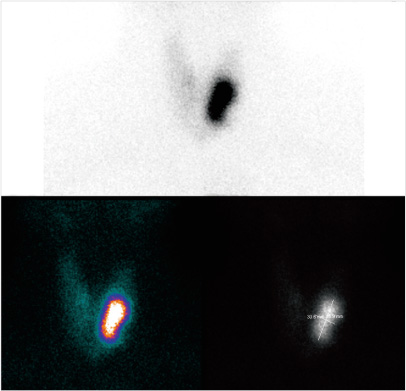Endocrinol Metab.
2012 Mar;27(1):59-62. 10.3803/EnM.2012.27.1.59.
Papillary Thyroid Carcinoma Manifesting as an Autonomously Functioning Thyroid Nodule
- Affiliations
-
- 1Division of Endocrinology, Department of Internal Medicine, Soonchunhyang University College of Medicine, Cheonan, Korea. yeojoo@schmc.ac.kr
- 2Department of Pathology, Soonchunhyang University College of Medicine, Cheonan, Korea.
- KMID: 2134819
- DOI: http://doi.org/10.3803/EnM.2012.27.1.59
Abstract
- Hyperfunctioning thyroid carcinoma is very rare. Hence, radionuclide imaging of thyroid hot nodules usually suggests a benign tumor, and less than 4% of cases have been reported as malignant. We would like to present a case of a hyperfunctioning papillary thyroid carcinoma that was initially treated with radioactive iodine. A 58-year-old woman was referred to our hospital for palpable thyroid nodule and a 5-kg weight loss within 6 months. Thyroid function test revealed thyrotoxicosis, and thyroid autoantibodies were absent. 99mTc thyroid scintigraphy showed a 2 x 2 cm-sized hyperactive hot nodule at the left lobe. Despite radioactive iodine treatment with a dose of 10 mCi 131I, thyroid function did not improve. Fine needle aspiration revealed papillary thyroid cancer. The patient underwent total thyroidectomy. Although clinical features and thyroid scans suggest a benign nodule, the possibility of malignancy should not be ruled out. Malignant thyroid hot nodules are rare; however, its possibility should be taken into account. Therefore, we suggest that ruling out malignancy by existing diagnostic guidelines can misdiagnose even a typical case with benign features. As thyroid nodule detection is getting sensitive and accurate, we present this case to discuss whether additional diagnostic approaches would be necessary for thyroid nodules.
Keyword
MeSH Terms
Figure
Cited by 2 articles
-
Ultrasonographic Characteristics of the Hyperfunctioning Thyroid Nodule and Predictive Factors for Thyroid Stimulating Hormone Suppression
Won Sang Yoo, Hoon Sung Choi
Int J Thyroidol. 2019;12(1):35-43. doi: 10.11106/ijt.2019.12.1.35.Papillary Thyroid Carcinoma Presented as a Hot Nodule with Hyperthyroidism
Sung Hye Kong, Seo Young Lee, Ye Seul Yang, Jae Hoon Moon
Int J Thyroidol. 2016;9(1):47-50. doi: 10.11106/ijt.2016.9.1.47.
Reference
-
1. American Thyroid Association (ATA) Guidelines Taskforce on Thyroid Nodules and Differentiated Thyroid Cancer. Cooper DS, Doherty GM, Haugen BR, Kloos RT, Lee SL, Mandel SJ, Mazzaferri EL, McIver B, Pacini F, Schlumberger M, Sherman SI, Steward DL, Tuttle RM. Revised American Thyroid Association management guidelines for patients with thyroid nodules and differentiated thyroid cancer. Thyroid. 2009. 19:1167–1214.2. Ashcraft MW, Van Herle AJ. Management of thyroid nodules. II: scanning techniques, thyroid suppressive therapy, and fine needle aspiration. Head Neck Surg. 1981. 3:297–322.3. Uludag M, Yetkin G, Citgez B, Isgor A, Basak T. Autonomously functioning thyroid nodule treated with radioactive iodine and later diagnosed as papillary thyroid cancer. Hormones (Athens). 2008. 7:175–179.4. Majima T, Doi K, Komatsu Y, Itoh H, Fukao A, Shigemoto M, Takagi C, Corners J, Mizuta N, Kato R, Nakao K. Papillary thyroid carcinoma without metastases manifesting as an autonomously functioning thyroid nodule. Endocr J. 2005. 52:309–316.5. Mizukami Y, Michigishi T, Nonomura A, Yokoyama K, Noguchi M, Hashimoto T, Nakamura S, Ishizaki T. Autonomously functioning (hot) nodule of the thyroid gland. A clinical and histopathologic study of 17 cases. Am J Clin Pathol. 1994. 101:29–35.6. Paschke R, Tonacchera M, Van Sande J, Parma J, Vassart G. Identification and functional characterization of two new somatic mutations causing constitutive activation of the thyrotropin receptor in hyperfunctioning autonomous adenomas of the thyroid. J Clin Endocrinol Metab. 1994. 79:1785–1789.7. Boelaert K. The association between serum TSH concentration and thyroid cancer. Endocr Relat Cancer. 2009. 16:1065–1072.8. Granter SR, Cibas ES. Cytologic findings in thyroid nodules after 131I treatment of hyperthyroidism. Am J Clin Pathol. 1997. 107:20–25.9. Tezelman S, Grossman RF, Siperstein AE, Clark OH. Radioiodine-associated thyroid cancers. World J Surg. 1994. 18:522–528.
- Full Text Links
- Actions
-
Cited
- CITED
-
- Close
- Share
- Similar articles
-
- Concurrent Papillary and Medullary Carcinoma of the Thyroid Gland
- A case of an autonomously functioning thyroid nodule combined with subacute thyroiditis
- Papillary Thyroid Carcinoma Hidden behind the Hot Nodule
- Autonomously functioning thyroid nodules
- Coexistence of Parathyroid and Papillary Thyroid Carcinoma





